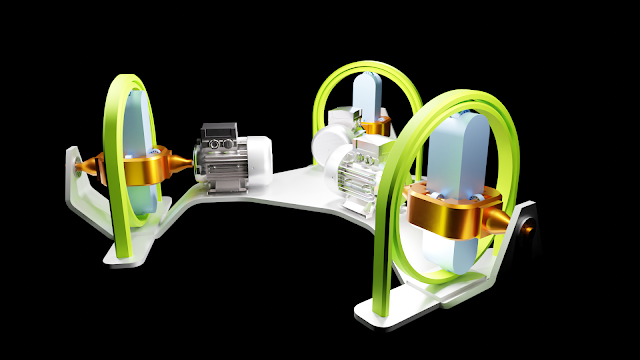Heavy equipment.
Three heavy stick propulsion with specific bearings system and three separated electric motors. However, for the better operation of the device, the three generators should be doubled with three additional generators, so there is the need of six generators where half of them would be rotate in one direction and another half in opposite direction. If the generators would be turned by 90 degrees in vertical plane than the three of them will be enough but then the electric motors can be connected to them through 90 degree angled conical gears.
I will add another explanation for the reluctant: let's say you have a bucket of water, sand or other heavy material at your disposal, then imagine that you are able to make circles in a vertical plane with this bucket, you know the force then spreads on all sides in the same direction with centrifugal force and there is no drive then any, except that the bucket is pulling your body weight in all directions. However, imagine that you are able to add sand to the bucket while it is still horizontal and moving in the upper hemisphere of the rotation, and imagine that you are removing sand from the bucket when it is on the other side horizontal so that it is moving again. was lighter then the force will not be the same in all directions, it will be greater at the top, where the centrifugal force will be magnified due to the increased mass.
This explanation does not necessarily mean that the whole system, according to this explanation, will work, because in this case, without the base on which someone is standing and rolling the bucket, the whole thing would not work, which would have to be reckoned with if the device were to be found in space, where there is a vacuum and there is no point of support. Therefore, among other things, each generator should be at least paired with the same generator, but with the opposite direction of rotation and synchronization. Which may also raise doubts among some who read this as to the effectiveness of this solution, because someone may think that this point of support is still needed, but please imagine that with a paired and synchronized system at the appropriate rotational speed, the point of support does not it is necessary because the excess and unbalanced centrifugal force causes it to hold the whole in place and even move according to the surplus force vector, even after removing the support. The kinetic energy acting on a mass is equal to the force of gravity when properly applied.










Komentarze
Prześlij komentarz